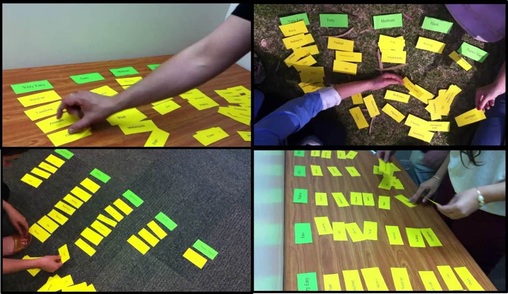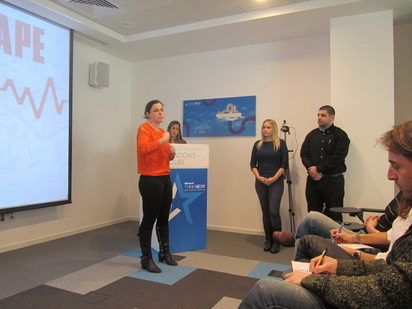In order to find out what is the difficulty level of recording each sound, we went to check it with the help of 10 anonymous students. We gave them a list of sounds and ask them to sort it from very easy to super hard.
Our main problem in the last project was that the user didn't have any motivation to record the sounds. Here we addressing that issue by developing a game app which defines the recording activity as a way to progress in the game. According to Caillois (1961), a game is an activity that is voluntary and enjoyable, separate from the real world, uncertain, unproductive in that the activity does not produce any goods of external value, and governed by rules. This game, enhances the intrinsic motivation of the user to record the sounds and therefore to contribute sounds into our database. Intrinsic motivation refers to doing something because it is inherently interesting or enjoyable (Deci & Ryan, 2000). In our game, the recording tasks will be presented as challenges in a range of difficulty levels, so the user will be able to choose the task according to his own abilities; from very easy to very difficult. Having challenges in the game is an important matter when developing a game (Malone & Lepper, 1987).
Each and every time we would discuss about the concept and main features of Soundscape, we got stuck with the same question, over and over again: Why would anyone use it? After consulting with different people, we wanted to examine a new way to motivate users to record sounds around them. We decided that the best way to motivate someone to do something is by challenging him- so we went for a game app that challenges people to record sounds. When starting our game design we found it best to rely on games that we already know they work- and so we decided to create a sound version of the OMG Pop mega hit Draw Something. The rules will be pretty simple- you challenge your friend to a dual of finding and recording original urban sounds. Here are a few initial mockups of the game: The questionnaire was distributed online to 106 anonymous participants via Facebook. It examined two main aspects:
1) The degree of which people is aware to urban sounds. 2) The ability and the desire of people to tag their emotions to a specific sound. The most interesting result regarded to the question: “How do you prefer to tag your emotion?” it seems that most of the people preferred tagging their emotions through word bank, and all the participants wanted to tag their emotion and identified with that need. Soundscape is based on the proven model of user-created content that fuels large social, data-driven projects such as Wikipedia, and Waze [1]. We think of it as draw something for sounds.
As a content driven project, Soundscape provides the ability to visualize information about sounds and emotions, displaying information from trends in large social groups to personal information to each user on a map. We anticipate that large content contributors will comprise about 12% of our total user community, just as Wikipedia article authors and Waze [1] reporters are about 1% [2] of their respective user base, while the other 99% will be passive users who simply consume the content, not create it. Content contributors will be individuals who are highly interested in the subject, motivated to help the mapping effort, whereas content consumers will be able to use the information for a variety of different applications, for example official city planners using the information to manage noise pollution in areas or account for effects of bus routes in residential neighborhoods. This content will be shared in a manner similar to Waze [1] displayed directly on a map. Tags of different sounds and their accompanying emotions will be displayed on the map, just as traffic jams and road hazards are displayed on Waze [1]. The individual experience will resemble a user’s experience on Instagram – to the single user, Soundscape will provide another way to document their urban experiences with others by incorporating a new sense and opening up a new medium – recording sounds, and emotions and visualizing the information on a map. We anticipate that only a small percentage of tagged sounds will be relevant and useful to a large-scale mapping effort, however sounds that receive many tags from the same area will reflect the actual state of urban sounds. 1 .Waze is a free social mobile app that enables drivers to build and use live maps, real-time traffic updates and turn-by-turn navigation for an optimal commute 2. (The 1% rule states that the number of people who create content on the Internet represents approximately of the people actually viewing that content) We hope that the maps and visualizations provided by Soundscape will increase citizens’ awareness of their urban acoustical environment, on both a personal and city-wide level. Hopefully the content made available by Soundscape will improve peoples’ lives, however marginally, by bringing an important issue to their awareness and providing a platform to understand the problem and devise solutions to deal with it.
We see Soundscape as the base platform for sound/acoustic applications across the globe, by providing a large database with tools to access the vast amounts of information easily. Possible applications include:
John is a 25 year old student at the IDC, Israel. Just like most other students his age, John moved to Tel Aviv to be closer to the IDC. As part of the change, moving from a quiet kibbutz to a large city, John has had to adapt to the vibrant, loud city life. From jazz jam sessions by street performers, the sounds of customers at the nearby coffee-shop to the rush hour traffic sounds and constant car horns, John finds himself constantly tired and agitated unable to concentrate during class. John’s good friend Lihi told him that the Soundscape application that creates and shows maps of sounds and emotions on a city map might be able to help him.
Feeling encouraged by this, John decides to try Soundscape, and after installing the application he starts documenting the sounds he hears and consciously linking them to the emotions he feels throughout the day. In the morning commute to the IDC he records the sound of the approaching bus, while waiting for his ride, tagging the bus sound as “annoying”. The information is immediately displayed on his personal map, coloring that area with the color he selected to represent negative emotions. Later that afternoon, while sitting at the park near his apartment John records the birds chirping, tagging these sounds as “soothing”. The next day he tags a street musician playing a saxophone with his emotional response “happy”. All of this information is accumulated and displayed on the map, coloring the areas of the map in colors representing positive emotions. After using the application for several weeks, John looks at the map and sees that the area near the park, next to his apartment constantly evokes positive feelings. He understands that this area provides a place where he can relax and study effectively, and decides that from now on he will go study there whenever possible, and buys earplugs to use when going to sleep. A week later John notices that he is a lot more relaxed and successful in his coursework. On Thursday, January 17th we presented the following presentation at the Microsoft Accelerator in Herzeliya, Israel. The presentation showed our first few steps towards formatting our idea.
HOW ARE WE GOING TO DO ALL THAT? (TECHNICAL ASPECTS) Soundscape will be developed as a two part system – the users’ client used for recording sounds and viewing the maps, and the server. The client will be developed for Android, utilizing the existing capabilities of smartphones to record data and provide information about location, time of day and other measurements about the recording. Furthermore, the map view will be built on the Google Map API. The server will provide all functionality for the client to send information and retrieve it from the database. Soundscape’s server will provide an open-source API to allow the community to contribute to the project, improving and enhancing its algorithms. The API expose features from statistical information and queries to sound analysis opportunities when pattern recognition algorithms are coupled with the large database of sounds in Soundscape’s database. This will also open up a slew of possible applications based on Soundscape as the backend service provider and data analyzer. |


 RSS Feed
RSS Feed